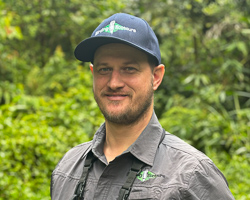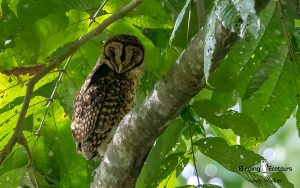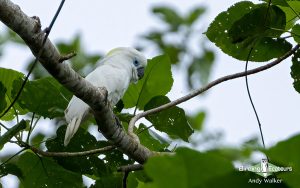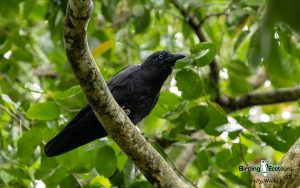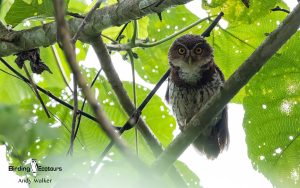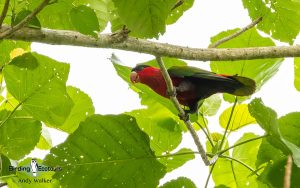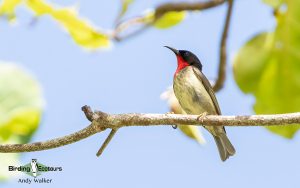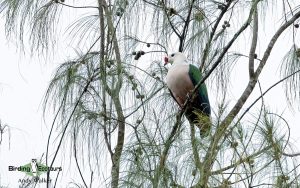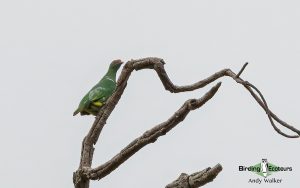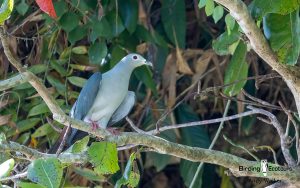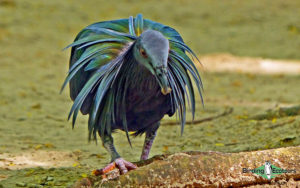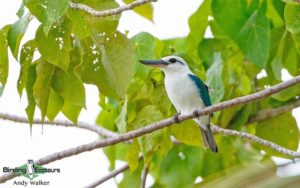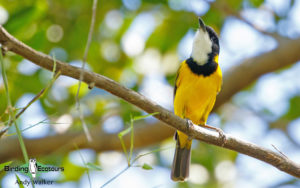Papua New Guinea: New Britain Premium Extension – Bismarck Archipelago Birding
Go to: New Guinea Birding Tours | Papua New Guinea Birding Tours | Birding Tours in Asia | All our birding tours
Papua New Guinea: New Britain Premium Extension – Bismarck Archipelago Birding
August 2026
This incredibly exciting premium extension to New Britain, the largest island in the Bismarck Archipelago of Papua New Guinea and a certified tropical paradise, offers the chance for some rarely seen and stunningly beautiful endemic birds.
 Purple-bellied Lory is one of the many species of colorful parrots to be found on this New Britain birding tour (photo Dejan Stojanovic).
Purple-bellied Lory is one of the many species of colorful parrots to be found on this New Britain birding tour (photo Dejan Stojanovic).
We stay in a luxurious dive resort with excellent facilities making for a fantastic and relaxing bird-filled experience (and some amazing snorkeling at a wonderful reef too). This tour is an ideal add-on to our Papua New Guinea: Birding Attenborough’s Paradise, where we look for Blue Bird-of-paradise and a multitude of other jaw-dropping species.
On this short New Britain bird tour, we will find numerous New Britain endemics, along with plenty of Bismarck Archipelago endemics, and some Solomon Islands endemics too. Some of the many possible highlights include Melanesian Megapode, Blue-eyed Cockatoo, Black-capped Paradise Kingfisher, Bismarck (New Britain) Pitta, and Golden Masked Owl. We will also enjoy sightings of numerous parrots, pigeons, kingfishers, and exciting passerines that will provide an incredible splash of color.
Itinerary (6 days/5 nights)
Day 1. Arrival in Port Moresby
After your arrival at Jacksons International Airport in Port Moresby, Papua New Guinea (PNG), you will transfer to our comfortable hotel for the night. Time after arrival is at your own leisure. We will meet for a group welcome dinner in the evening.
Overnight: Port Moresby
Day 2. Fly from Port Moresby to Hoskins, New Britain, transfer to, and birding at Walindi
We will depart from Jacksons International Airport, Port Moresby in the morning for Hoskins Airport in New Britain. On arrival we will transfer to our extremely comfortable base at Walindi Plantation Resort (Walindi Dive Resort) for the four nights of our stay on the island.
Not only is Walindi Plantation Resort a great and luxurious place to stay in terms of accommodation, meals, and diving, it also offers excellent on-site birding and access to numerous nearby areas that are perfect for finding a range of New Britain endemic birds and wider Bismarck Archipelago and Solomon Islands endemic birds.
After checking in to the resort we will get on with some birding around the grounds. The resort includes a mosaic of habitats, with lowland rainforest, open landscaped gardens, and beachfront, all resulting in some great birds, and here we might find Red-knobbed Imperial Pigeon, Blue-eyed Cockatoo, White-necked (Pied) Coucal, New Britain Boobook, New Britain Friarbird, Ashy Myzomela, Bismarck Crow, Long-tailed Myna, Red-banded Flowerpecker, Red-flanked Lorikeet, Purple-bellied Lory, Buff-faced Pygmy Parrot, and Moustached Treeswift.
Overnight: Walindi Plantation Resort
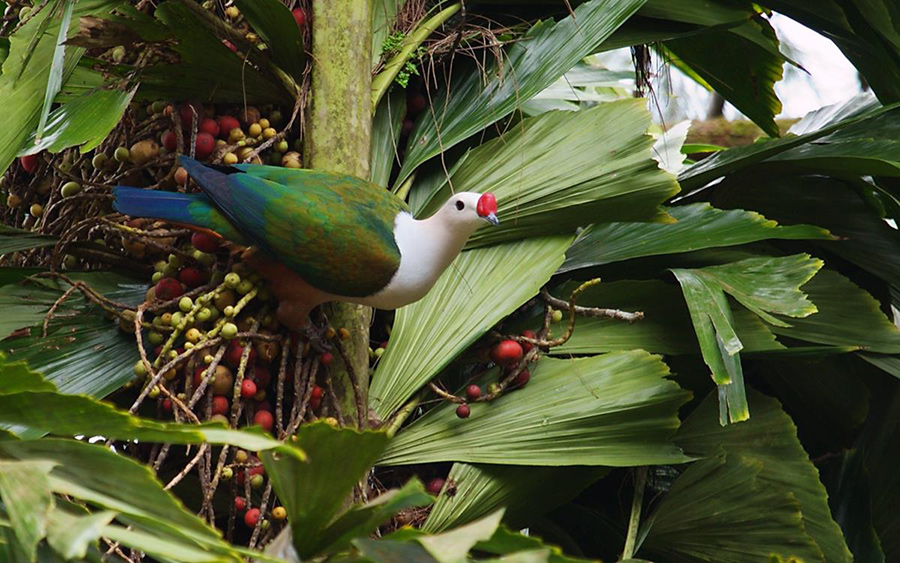
Day 3. Birding New Britain (Birding Garu Wildlife Management/Conservation Area and Kulu River)
We will spend our morning birding at Garu Wildlife Management/Conservation Area. This is a large reserve incorporating a range of habitats, including some excellent lowland rainforest and geothermally heated hot rivers! This site is of huge importance for breeding Melanesian Megapode, one of our main targets here. This area is also excellent for the endemic Black-capped Paradise Kingfisher along with other endemics like Pink-legged Rail, Black Honey Buzzard, Finsch’s Imperial Pigeon, Knob-billed Fruit Dove, Blue-eyed Cockatoo, Purple-bellied Lory, Violaceous Coucal, White-necked (Pied) Coucal, White-mantled Kingfisher, Ashy Myzomela, Bismarck Whistler, Black-tailed Monarch, Velvet Flycatcher, and Red-banded Flowerpecker. Plenty of other species can be found too, such as Papuan Eclectus, Red-flanked Lorikeet, Coconut Lorikeet, and Buff-faced Pygmy Parrot.
We will spend the afternoon birding at Kulu River. We will cover grassland habitats along with river flats and oil palm plantations. A wide range of species are possible and likely to include crakes, bitterns, shorebirds, and waterfowl. Some of the more notable species here include Pied Cuckoo-Dove, White-bibbed Fruit Dove, Knob-billed Fruit Dove, Red-knobbed Imperial Pigeon, Nicobar Pigeon, Pink-legged Rail, Blue-eyed Cockatoo, New Britain Boobook, Bismarck Kingfisher, Bismarck (New Britain) Pitta, Black-tailed Monarch, White-backed Woodswallow, and Red-banded Flowerpecker, along with Spotted Whistling Duck, King Quail, and Black Bittern.
Overnight: Walindi Plantation Resort
Day 4. Birding Kimbe Bay by boat, including Restorf, Malumalu, and Schaumann Islands, with afternoon birding at Numundo
During the morning we will take a boat into Kimbe Bay where we will visit the rainforest-clad Restorf, Malumalu, and Schaumann Islands. We will hope to find fruiting trees which could be busy with pigeons and parrots, and we can also find exciting endemic passerines here. Some of the targets will include Melanesian Megapode, Nicobar Pigeon, Island Imperial Pigeon, Yellowish Imperial Pigeon, Yellow-bibbed Fruit Dove, Mackinlay’s Cuckoo-Dove, White-bellied Sea Eagle, Lesser Frigatebird, Great Frigatebird, Beach Kingfisher, Sclater’s Myzomela, Mangrove Golden Whistler, Island Monarch, Velvet Flycatcher, and Red-banded Flowerpecker. We will also keep our eyes peeled for Heinroth’s Shearwater and Beck’s Petrel while on our boat trip.
Our afternoon birding will take us to Numundo, where we will look for birds found in disturbed habitats such as oil palm plantations and grasslands. We will check this area out for Buff-bellied Mannikin, Papuan Grassbird, Australian Reed Warbler, Golden-headed Cisticola, Black Bittern, Spotted Whistling Duck, King Quail, White-browed Crake, and Pale-vented Bush-hen. We will also look out for other wildfowl and shorebirds.
Overnight: Walindi Plantation Resort
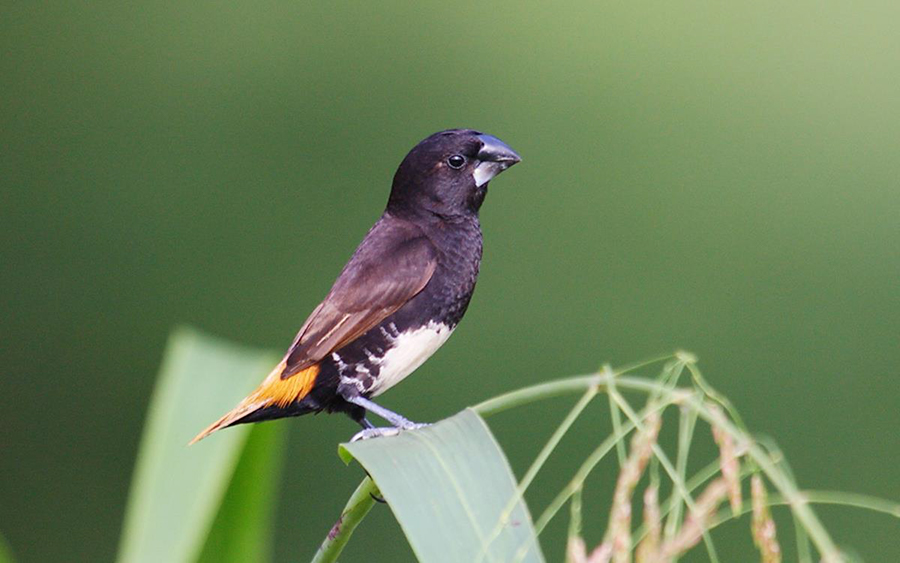
Day 5. More New Britain Birding!
We will spend more time birding Kulu River, where we will look for those birds mentioned in Day 3, as well as any others we can find. We will also visit the lowland forest at Hela where we can walk through the forest looking for mixed feeding flocks and look for birds such as Melanesian Megapode, Black Honey Buzzard, Knob-billed Fruit Dove, Finsch’s Imperial Pigeon, Black Imperial Pigeon, Blue-eyed Cockatoo, Bismarck Hanging Parrot, Black-capped Paradise Kingfisher, Bismarck Kingfisher, New Britain Dwarf Kingfisher, White-mantled Kingfisher, Black-bellied Myzomela, Black-tailed Monarch, and Red-banded Flowerpecker. We will look for Golden Masked Owl in the evening if we’ve not seen it before now and we might also find Large-tailed Nightjar and Nankeen Night Heron.
Overnight: Walindi Plantation Resort
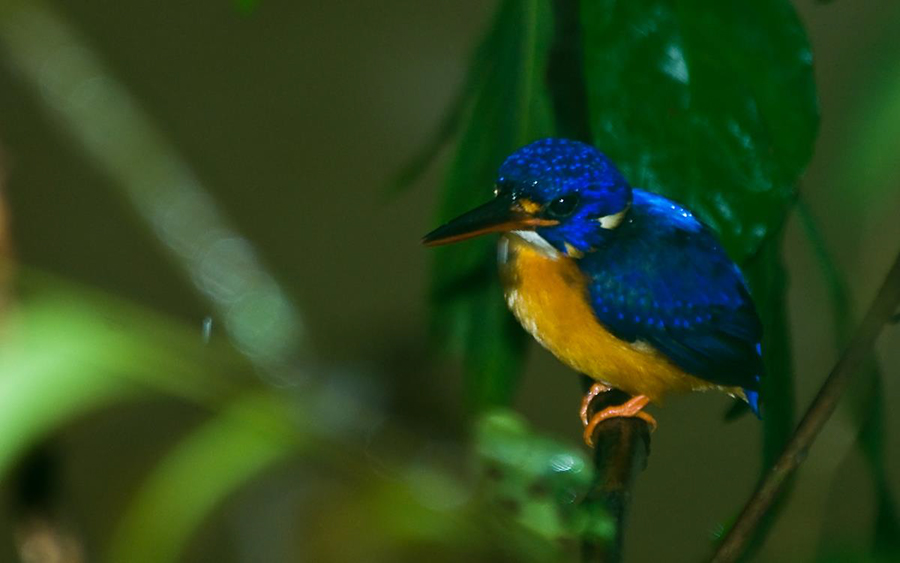
Day 6. Walindi to Port Moresby and departure from Papua New Guinea
We will transfer from Walindi to Hoskins Airport before flying on to Jacksons International Airport, Port Moresby. If you are not on our Papua New Guinea: Birding Attenborough’s Paradise tour your tour will conclude and you will be free to depart in the evening(please check international flight timings with us prior to booking any flights so we can check them against the flights between New Britain and Port Moresby).
If you are continuing with our Papua New Guinea tour, you will commence Day 1 of that tour, likely with some late afternoon birding at the Pacific Adventist University (depending on the time of the internal flight between Hoskins and Port Moresby).
Overnight: Not included (unless taking part in our Papua New Guinea tour)
Please note that the itinerary cannot be guaranteed as it is only a rough guide and can be changed (usually slightly) due to factors such as availability of accommodation, updated information on the state of accommodation, roads, or birding sites, the discretion of the guides and other factors. In addition, we sometimes have to use a different international guide from the one advertised due to tour scheduling.
Download Itinerary
Papua New Guinea: New Britain Premium Extension – Bismarck Archipelago Birding Trip Report, August 2023
14 – 19 AUGUST 2023
By Andrew Walker
DOWNLOAD TRIP REPORT
Overview
This Papua New Guinea birding tour focused on the province of New Britain, the largest island in the Bismarck Archipelago. The tour started in Port Moresby on the 14th of August 2023 and ended back there on the 19th of August 2023. During this New Britain birding tour, we spent the duration of our stay on the island at the excellent and luxurious Walindi Plantation (Dive) Resort, a wonderful base for local birding excursions. Our birding was focused on the endemic birds of New Britain, along with several Bismarck Archipelago and Solomon Islands regional endemics. The weather was unseasonably wet during our tour, and we lost valuable birding time because of this; however, we still managed to find a high number of the most-wanted species thanks to the help of our excellent local guiding team.
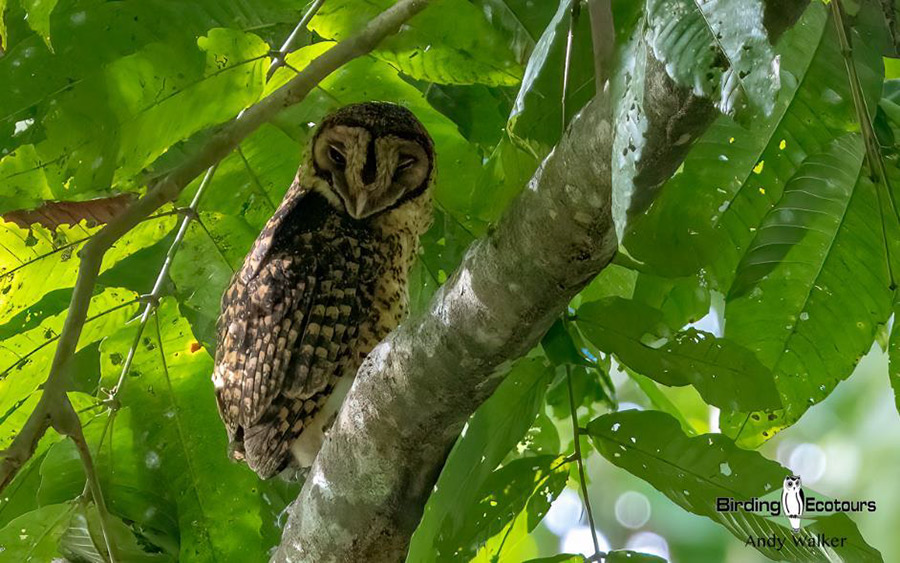
The rare New Britain endemic Golden Masked Owl was a highlight on our New Britain birding tour; we enjoyed great views of this highly sought-after species, known from very few sites.
We recorded 93 species on the tour (two of these heard only). Trip lists follow the report. The list of highlights was very long and included Melanesian Megapode, Red-knobbed Imperial Pigeon, Yellowish Imperial Pigeon, Island Imperial Pigeon, Finsch’s Imperial Pigeon, Nicobar Pigeon, Knob-billed Fruit Dove, MacKinlay’s Cuckoo-Dove, Blue-eyed Cockatoo, Singing Parrot, Purple-bellied Lory, Bismarck Hanging Parrot, Buff-faced Pygmy Parrot, White-necked Coucal, Violaceous Coucal, Blyth’s Hornbill, Golden Masked Owl, New Britain Boobook, Black-capped Paradise Kingfisher, New Britain Dwarf Kingfisher, White-mantled Kingfisher, Melanesian Kingfisher, Beach Kingfisher, Bismarck Pitta (New Britain Pitta), Bismarck Crow, Spangled (Bismarck) Drongo, New Britain Friarbird, Sclater’s Myzomela, Black-bellied Myzomela, Ashy Myzomela, Black-tailed Monarch, Velvet Flycatcher, Long-tailed Myna, Red-banded Flowerpecker, and Buff-bellied Mannikin. Two Wood Sandpipers in a flooded field were a surprise find and were vagrants to New Britain.
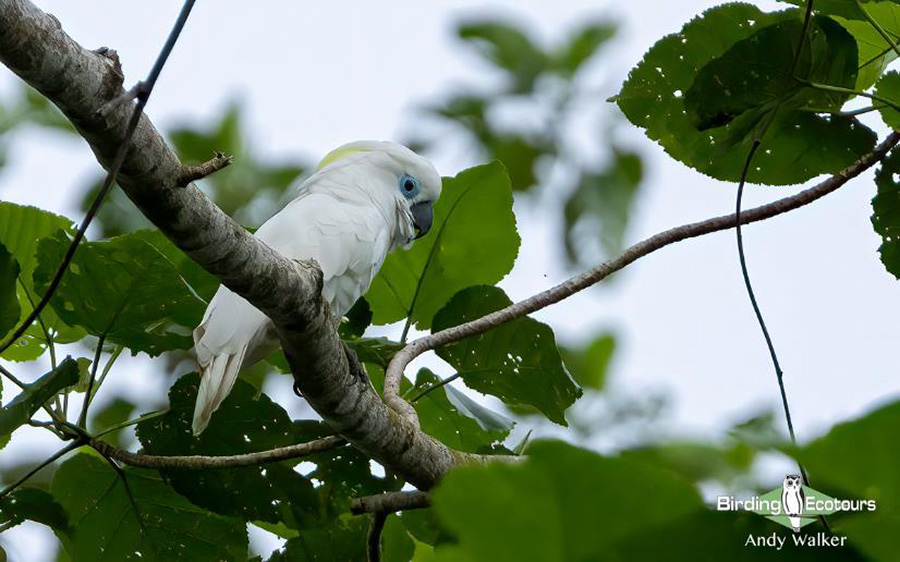
The uncommon New Britain endemic, Blue-eyed Cockatoo, showed well during our New Britain birding tour.

The impressive-looking Red-knobbed Imperial Pigeon was commonly seen and heard in the resort gardens along with many other great birds.
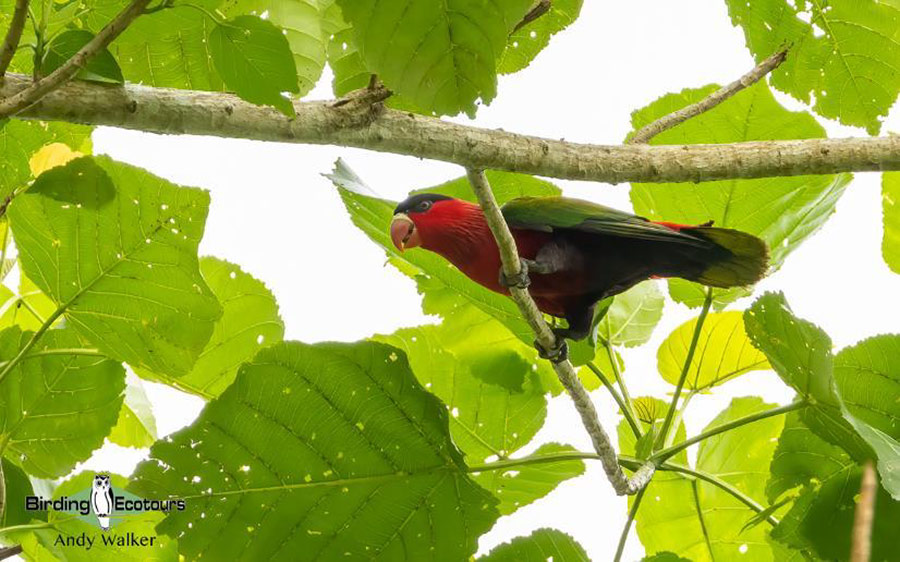
We had great looks at Purple-bellied Lory on many occasions during the New Britain birding tour, and it was another stunning bird found around the rooms in our resort.
Detailed Report
Day 1, 14th August 2023. Arrival in Port Moresby
An arrival day in Port Moresby. We enjoyed our welcome dinner together and discussed what we were hoping to see on this New Britain birding tour.
Day 2, 15th August 2023. Flight between Port Moresby and Hoskins, New Britain, travel to and birding at Walindi Plantation (Dive) Resort
After breakfast in our very comfortable hotel in Port Moresby, we took a mid-morning flight from Port Moresby to Hoskins on the island of New Britain (via the city of Lae). We arrived at a rainy Hoskins Airport around noon and made the drive across to Walindi Plantation (Dive) Resort in time for a late lunch.
We spent the late afternoon dodging light rain showers and started our birding with some relaxed exploration of our dive resort grounds. The number of birds was impressive and included some great species in the trees around the rooms, including Red-knobbed Imperial Pigeon, Moustached Treeswift, Papuan Eclectus, Purple-bellied Lory, Bismarck Crow, Varied Triller, New Britain Friarbird, Willie Wagtail, Metallic Starling, Black Sunbird, and Olive-backed Sunbird. The coastal strip, including a nice intertidal area, gave us views of Black Bittern, Little Egret, Great Egret, Eurasian Whimbrel, Common Sandpiper, Osprey, Brahminy Kite, Common Kingfisher, and Sacred Kingfisher. As the afternoon progressed, the rain started to get more persistent and heavier, so we called time and prepared for dinner.
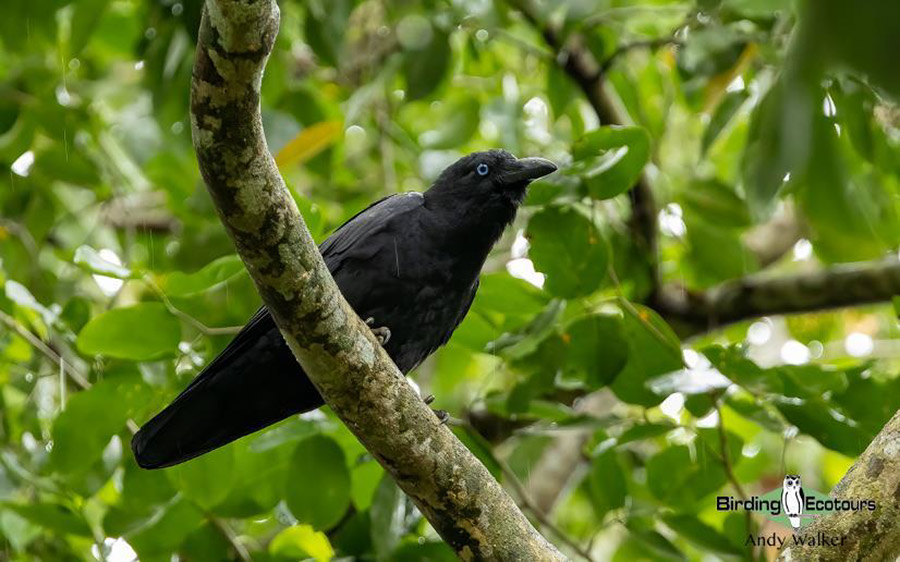
The regionally endemic Bismarck Crow was abundant in the resort grounds.
Day 3, 16th August 2023. Birding Kulu River
The rain that had been falling since our arrival in New Britain yesterday, continued all night and all of this morning too, which really ruined our morning birding session. Instead of being able to walk around, we drove some increasingly waterlogged back roads, found a few targets, and tried to make the most of the awful (and out of season) rainy conditions. Black Bitterns, Nankeen Night Herons, and Pacific Black Ducks were numerous (including the unusual sight of an albino Black Bittern!). Along the roads, we also found several Red-knobbed Imperial Pigeons, Stephan’s Emerald Doves, Melanesian Kingfishers, Coconut Lorikeets, Rainbow Bee-eaters, and Buff-bellied Mannikins. The biggest surprise was finding two Wood Sandpipers in a flooded field, a vagrant to New Britain. We called in at some grassland where we found more Buff-bellied Mannikins, Australian Reed Warbler, Papuan Grassbird, Golden-headed Cisticola, Swinhoe’s Snipe, and a family group of Buff-banded Rails.
Thankfully, the weather improved for our afternoon birding session, and we were rewarded with some great birds and excellent sightings of many of them. As well as most of the birds we’d found in the morning, some of the other highlights included Blue-eyed Cockatoo, Purple-bellied Lory, Bismarck Hanging Parrot, New Britain Boobook, Yellowish Imperial Pigeon, Amboyna Cuckoo-Dove, White-necked Coucal, Violaceous Coucal, Blyth’s Hornbill, White-rumped Swiftlet, Long-tailed Myna, Spangled (Bismarck) Drongo, Northern Fantail, and as dusk approached, a brief Melanesian Megapode.
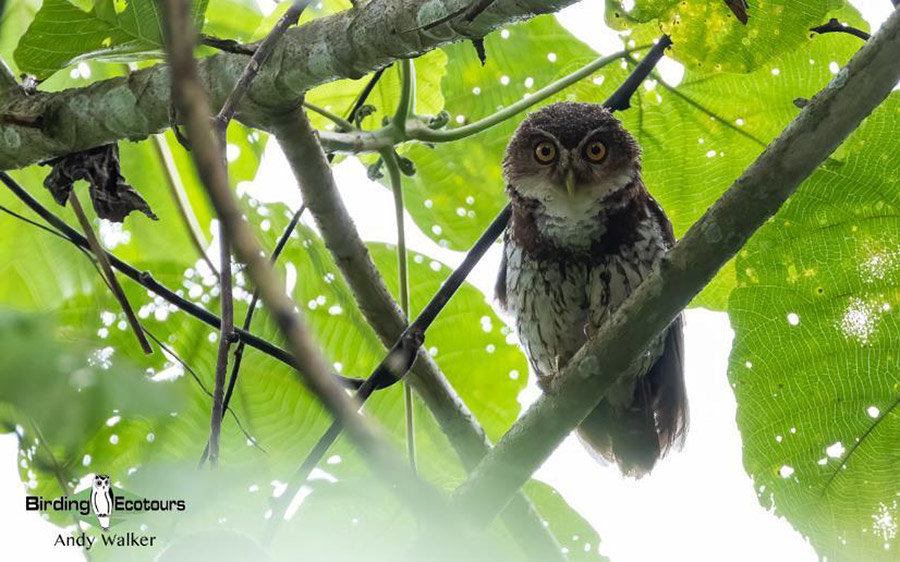
We had a nice surprise finding a pair of New Britain Boobooks in the late afternoon.
Day 4, 17th August 2023. Birding Kimbe Bay and Walindi Plantation Resort area
We spent the morning exploring Kimbe Bay by boat, a fantastic way to see this beautiful area. Birds were plentiful, and we checked out Restorf Island, Small Malumalu Island, and Large Malumalu Island. The most dominant bird was Island Imperial Pigeon, a species present in large numbers, with their call echoing all around us. We briefly glimpsed two Nicobar Pigeons and also found Mackinlay’s Cuckoo-Dove, Yellowish Imperial Pigeon, and Stephan’s Emerald Dove. Beach Kingfisher provided another highlight, with both Melanesian Kingfisher and Sacred Kingfisher also recorded. Small birds noted on the islands included Sclater’s Myzomela, Ashy Myzomela, Mangrove Golden Whistler, Island Monarch, Shining Flycatcher, and Metallic Starling. Gorgeous Rainbow Bee-eaters were overhead, as were Brahminy Kite and Osprey. On the water and exposed reefs (when the tide receded), we found Pacific Reef Heron, Lesser Frigatebird, Black-naped Tern, Common Tern, Greater Crested Tern, and Black Noddy. Most of the group spent some time snorkeling at one of the reefs, with rave reviews of the stunning fish life and coral present.
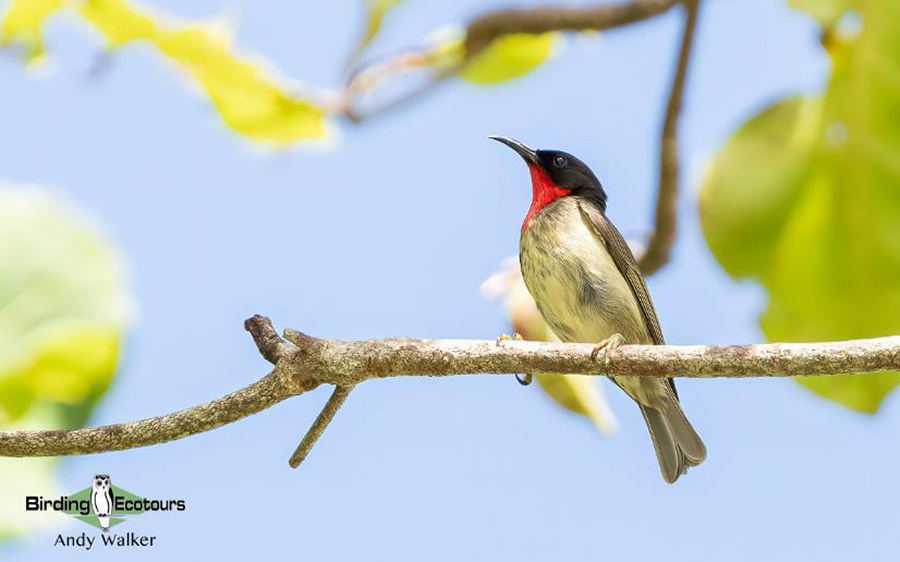
The pretty Sclater’s Myzomela eventually showed well after lots of brief and flighty views.
During the afternoon, some interesting birds were spotted around the resort grounds, including Oriental Hobby, New Britain Friarbird, and Buff-faced Pygmy Parrot. We took a drive to a nearby village, where we found one of the top targets of the tour, the rare Golden Masked Owl (see trip report cover image). We had excellent views of a roosting bird, a real tour highlight. After that, we explored a small patch of forest, where we had Black-capped Paradise Kingfisher; though heard by all, it was only seen by a couple of people, so we would need to hope for a further opportunity the following day for others to get a sight of this beautiful bird. Here, we also found Blyth’s Hornbill, Blue-eyed Cockatoo, Papuan Eclectus, Purple-bellied Lory, Yellowish Imperial Pigeon, Red-knobbed Imperial Pigeon, Long-tailed Myna, and Forest Kingfisher.
Day 5, 18th August 2023. Birding Garu Wildlife Management Area and Kulu River
We spent most of the day birding at Garu Wildlife Management Area. Again, we had to deal with rain, which persisted for most of the morning, and the bird activity was down because of it, especially during the first few hours of the day. We found several new birds (or improved our views of previously seen species) when conditions improved, and these included Melanesian Megapode, Black-capped Paradise Kingfisher, and White-mantled Kingfisher. A flowering tree was busy with a noisy flock of Red-flanked Lorikeets, along with a couple of Ashy Myzomelas and Black-bellied Myzomelas. Nearby, a huge tree was full of Buff-faced Pygmy Parrots, though they were extremely tough to see as they were just so tiny! Other species like Blue-eyed Cockatoo, Papuan Eclectus, Purple-bellied Lory, Long-tailed Myna, Black-tailed Monarch, Northern Fantail, Varied Triller, Knob-billed Fruit Dove, Red-knobbed Imperial Pigeon, and Finsch’s Imperial Pigeon, were also seen.
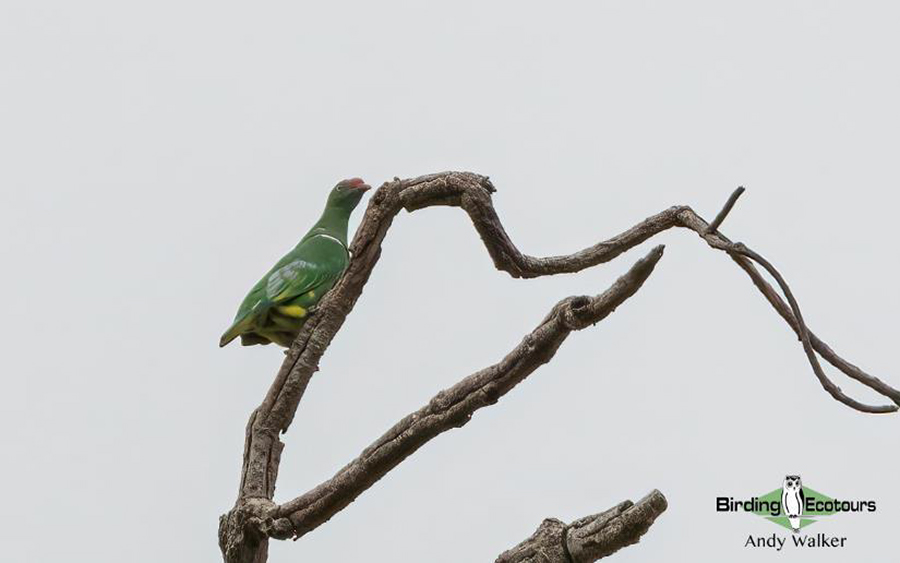
Knob-billed Fruit Dove is endemic to the Bismarck Archipelago.
As we wandered along various sections of the road through the management area, we found Blyth’s Hornbill, Red-banded Flowerpecker, Slaty-mantled Goshawk, Variable Goshawk, Superb Fruit Dove, White-necked Coucal, New Britain Dwarf Kingfisher, Singing Parrot, White-bellied Cuckooshrike, Spangled (Bismarck) Drongo, Velvet Flycatcher, Bismarck Crow, Black Sunbird, and more.
In the mid-afternoon, we called back to the Kulu River area, where we spent a couple of hours stalking a Bismarck Pitta (New Britain Pitta). It was seen by some, but unfortunately, not all of the group. Their shyness and preference for dense forests make them tough birds to connect with.
Day 6, 19th August 2023. Departure from Hoskins, New Britain
After a final breakfast at the delightful Walindi Plantation Resort, we traveled to Hoskins Airport and took our flight back to Port Moresby, where this short New Britain birding tour ended.
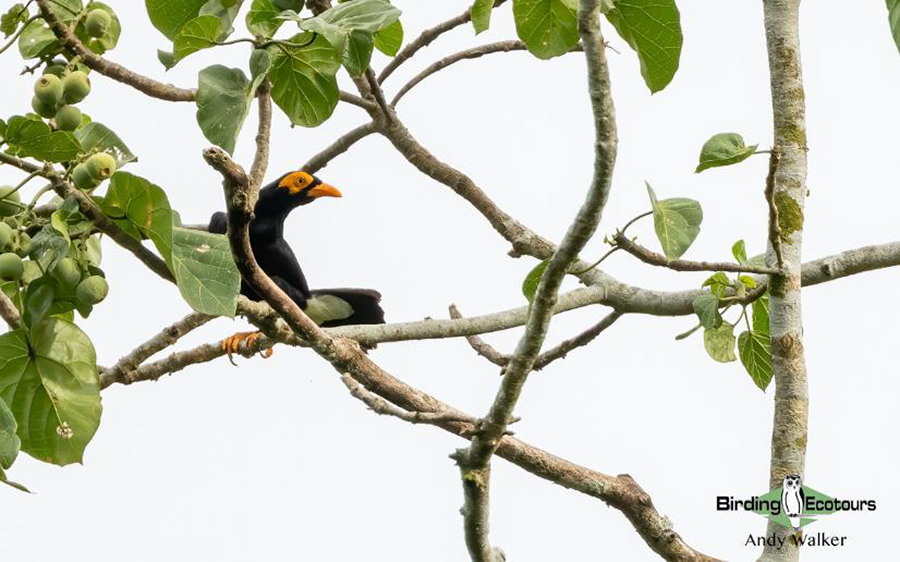
Long-tailed Myna was common but often high in fruiting trees.
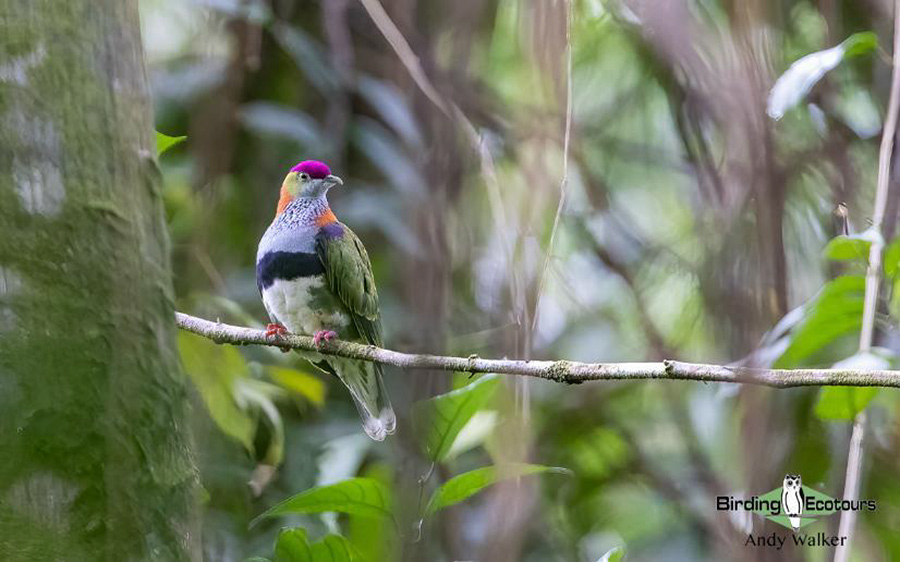
Although widespread, Superb Fruit Dove is one spectacular species and always nice to see.
Bird List – Following IOC (13.2)
Birds ‘heard only’ are marked with (H) after the common name, all other species were seen. The following notation after species names is used to show conservation status following BirdLife International: VU = Vulnerable.
| Common Name | Scientific Name |
| Ducks, Geese, Swans (Anatidae) | |
| Pacific Black Duck | Anas superciliosa |
| Megapodes (Megapodiidae) | |
| Melanesian Megapode | Megapodius eremita |
| Pheasants & Allies (Phasianidae) | |
| King Quail (H) | Synoicus chinensis |
| Treeswifts (Hemiprocnidae) | |
| Moustached Treeswift | Hemiprocne mystacea |
| Swifts (Apodidae) | |
| Glossy Swiftlet | Collocalia esculenta |
| White-rumped Swiftlet | Aerodramus spodiopygius |
| Uniform Swiftlet | Aerodramus vanikorensis |
| Cuckoos (Cuculidae) | |
| White-necked Coucal | Centropus ateralbus |
| Violaceous Coucal | Centropus violaceus |
| Shining Bronze Cuckoo (H) | Chrysococcyx lucidus |
| Brush Cuckoo | Cacomantis variolosus |
| Pigeons, Doves (Columbidae) | |
| Amboyna Cuckoo-Dove | Macropygia amboinensis |
| MacKinlay’s Cuckoo-Dove | Macropygia mackinlayi |
| Pied Cuckoo-Dove | Reinwardtoena browni |
| Stephan’s Emerald Dove | Chalcophaps stephani |
| Nicobar Pigeon | Caloenas nicobarica |
| Superb Fruit Dove | Ptilinopus superbus |
| Knob-billed Fruit Dove | Ptilinopus insolitus |
| Red-knobbed Imperial Pigeon | Ducula rubricera |
| Finsch’s Imperial Pigeon | Ducula finschii |
| Island Imperial Pigeon | Ducula pistrinaria |
| Yellowish Imperial Pigeon | Ducula subflavescens |
| Rails, Crakes & Coots (Rallidae) | |
| Buff-banded Rail | Hypotaenidia philippensis |
| Sandpipers, Snipes (Scolopacidae) | |
| Eurasian Whimbrel | Numenius phaeopus |
| Swinhoe’s Snipe | Gallinago megala |
| Common Sandpiper | Actitis hypoleucos |
| Wood Sandpiper | Tringa glareola |
| Gulls, Terns, Skimmers (Laridae) | |
| Black Noddy | Anous minutus |
| Greater Crested Tern | Thalasseus bergii |
| Black-naped Tern | Sterna sumatrana |
| Common Tern | Sterna hirundo |
| Frigatebirds (Fregatidae) | |
| Lesser Frigatebird | Fregata ariel |
| Cormorants, Shags (Phalacrocoracidae) | |
| Little Pied Cormorant | Microcarbo melanoleucos |
| Herons, Bitterns (Ardeidae) | |
| Black Bittern | Ixobrychus flavicollis |
| Nankeen Night Heron | Nycticorax caledonicus |
| Eastern Cattle Egret | Bubulcus coromandus |
| Great Egret | Ardea alba |
| Little Egret | Egretta garzetta |
| Pacific Reef Heron | Egretta sacra |
| Ospreys (Pandionidae) | |
| Osprey | Pandion haliaetus |
| Kites, Hawks, Eagles (Accipitridae) | |
| Variable Goshawk | Accipiter hiogaster |
| Slaty-mantled Goshawk – VU | Accipiter luteoschistaceus |
| Brahminy Kite | Haliastur indus |
| White-bellied Sea Eagle | Haliaeetus leucogaster |
| Barn Owls (Tytonidae) | |
| Golden Masked Owl – VU | Tyto aurantia |
| Owls (Strigidae) | |
| New Britain Boobook – VU | Ninox odiosa |
| Hornbills (Bucerotidae) | |
| Blyth’s Hornbill | Rhyticeros plicatus |
| Kingfishers (Alcedinidae) | |
| Black-capped Paradise Kingfisher | Tanysiptera nigriceps |
| Forest Kingfisher | Todiramphus macleayii |
| White-mantled Kingfisher | Todiramphus albonotatus |
| Melanesian Kingfisher | Todiramphus tristrami |
| Beach Kingfisher | Todiramphus saurophagus |
| Sacred Kingfisher | Todiramphus sanctus |
| Common Kingfisher | Alcedo atthis |
| New Britain Dwarf Kingfisher | Ceyx sacerdotis |
| Caracaras, Falcons (Falconidae) | |
| Oriental Hobby | Falco severus |
| Bee-eaters (Meropidae) | |
| Rainbow Bee-eater | Merops ornatus |
| Cockatoos (Cacatuidae) | |
| Blue-eyed Cockatoo – VU | Cacatua ophthalmica |
| Old World Parrots (Psittaculidae) | |
| Buff-faced Pygmy Parrot | Micropsitta pusio |
| Papuan Eclectus | Eclectus polychloros |
| Song Parrot | Geoffroyus heteroclitus |
| Red-flanked Lorikeet | Hypocharmosyna placentis |
| Purple-bellied Lory | Lorius hypoinochrous |
| Coconut Lorikeet | Trichoglossus haematodus |
| Bismarck Hanging Parrot | Loriculus tener |
| Pittas (Pittidae) | |
| Bismarck Pitta | Erythropitta novaehibernicae |
| Honeyeaters (Meliphagidae) | |
| Ashy Myzomela | Myzomela cineracea |
| Sclater’s Myzomela | Myzomela sclateri |
| Black-bellied Myzomela | Myzomela erythromelas |
| New Britain Friarbird | Philemon cockerelli |
| Cuckooshrikes (Campephagidae) | |
| White-bellied Cuckooshrike | Coracina papuensis |
| Varied Triller | Lalage leucomela |
| Whistlers & Allies (Pachycephalidae) | |
| Mangrove Golden Whistler | Pachycephala melanura |
| Drongos (Dicruridae) | |
| Spangled Drongo | Dicrurus bracteatus |
| Fantails (Rhipiduridae) | |
| Willie Wagtail | Rhipidura leucophrys |
| Northern Fantail | Rhipidura rufiventris |
| Monarchs (Monarchidae) | |
| Black-tailed Monarch | Symposiachrus verticalis |
| Island Monarch | Monarcha cinerascens |
| Shining Flycatcher | Myiagra alecto |
| Velvet Flycatcher | Myiagra eichhorni |
| Crows, Jays (Corvidae) | |
| Bismarck Crow | Corvus insularis |
| Swallows, Martins (Hirundinidae) | |
| Pacific Swallow | Hirundo tahitica |
| Reed Warblers & Allies (Acrocephalidae) | |
| Australian Reed Warbler | Acrocephalus australis |
| Grassbirds & Allies (Locustellidae) | |
| Papuan Grassbird | Cincloramphus macrurus |
| Cisticolas & Allies (Cisticolidae) | |
| Golden-headed Cisticola | Cisticola exilis |
| Starlings, Rhabdornises (Sturnidae) | |
| Metallic Starling | Aplonis metallica |
| Singing Starling | Aplonis cantoroides |
| Long-tailed Myna | Mino kreffti |
| Flowerpeckers (Dicaeidae) | |
| Red-banded Flowerpecker | Dicaeum eximium |
| Sunbirds (Nectariniidae) | |
| Black Sunbird | Leptocoma aspasia |
| Olive-backed Sunbird | Cinnyris jugularis |
| Old World Sparrows, Snowfinches (Passeridae) | |
| Eurasian Tree Sparrow | Passer montanus |
| Waxbills, Munias & Allies (Estrildidae) | |
| Buff-bellied Mannikin | Lonchura melaena |
| Total seen | 91 |
| Total heard only | 2 |
| Total recorded | 93 |
Mammal List
| Common Name | Scientific Name |
| Old World Fruit Bats (Pteropodidae) | |
| Great Flying Fox | Pteropus neohibernicus |
| Total | 1 |
Reptile List
| Common Name | Scientific Name |
| Geckos (Gekkonidae) | |
| Common House Gecko | Hemidactylus frenatus |
| Skinks (Scincidae) | |
| Pacific Bluetail Skink | Emoia caeruleocauda |
| Kopstein’s Emo Skink | Emoia jakati |
| Total | 3 |
Amphibian List
| Common Name | Scientific Name |
| True Toads (Bufonidae) | |
| Cane Toad | Rhinella marina |
| Total | 1 |
DOWNLOAD TRIP REPORT
This is a sample trip report. Please email us ([email protected]) for more trip reports from this destination.
Papua New Guinea: New Britain Premium Extension – Bismarck Archipelago Birding
Tour-specific Information
GENERAL INFORMATION ABOUT PAPUA NEW GUINEA CAN BE READ HERE
TOUR OUTLINE
This extension to our main Papua New Guinea birding tour, visits the West New Britain province of the country. We will search for New Britain, Bismarck Archipelago, and Solomon Islands endemics such as Blue-eyed Cockatoo, Black-capped Paradise Kingfisher, and Golden Masked Owl. This short New Britain birding tour starts and ends in Port Moresby where we stay at the wonderful Airways Hotel, and when we reach New Britain, we will base ourselves at the luxurious Walindi Plantation Resort.
DAILY ACTIVITIES, PHYSICAL REQUIREMENTS, AND TOUR PACE
During our New Britain birding tour, we will be based at one lodge for the duration of our stay on the island and we will make morning and afternoon (and evening) birding trips out from our base. All of these birding trips are optional. The resort is located about one hour’s drive from Hoskins Airport, our arrival point on the island. Most of our birding will be land-based, though we will take a boat out into Kimbe Bay to visit a few small islands. Our tour leader will have a telescope, though we don’t anticipate using it too much, and we do not recommend you bring your own scope on this trip (but do note the information on scopes in the “What to Bring: Other Items” section of the general information document).
The birding on this tour is considered easy to moderate, with nothing too steep and with ample time relaxing at our comfortable resort between birding sessions. Trails may be slippery if wet, but that is considered unlikely during the time of our visit.
TRANSPORTATION
We will use a range of modified land-based vehicles to get us around New Britain and to the various birding sites we will visit, these may include Toyota Hilux 4×4 type vehicles and minibuses/vans, depending on final group size.
During our stay at Walindi Plantation Resort, we will take a boat trip out into Kimbe Bay where we will visit the rainforest-clad Restorf, Malumalu, and Schaumann Islands for birding. Some birding will be boat-based, but we will also make a wet-landing on a beach to explore (weather and tide conditions allowing). We will position the boat in some shallow water and put a ladder down to help us get from the boat into the water and then ashore. There is a pier at the Walindi Plantation Resort for getting into and out of the boat here. There will also be an opportunity for snorkeling on the trip to the islands.
DOMESTIC FLIGHTS
We will take scheduled flights between Port Moresby and Hoskins Airport in New Britain. On these flights the hold baggage allowance is usually 35 pounds (lbs) / 16 kilograms (kgs), and the hand luggage allowance is 15 lbs (7kgs).
Please note that excess baggage (which you may have if taking part in our longer PNG birding tour) can be stored by our local team in a secure place in Port Moresby. If your bags are too heavy, they may be refused by the airline.
SAFETY AND SECURITY
Your safety and your security is our paramount concern on this New Britain birding tour, as it is on all of our birdwatching tours around the world. We have provided as much information within this tour-specific information and the Papua New Guinea general information, linked at the top of this document, as we can. It is essential you have read these documents (and the equally important documents linked from that document) ahead of the tour to be fully up to date on the latest safety and security situation in Papua New Guinea.
Care should be taken when swimming and snorkeling. The reef life is spectacular and some of the best diving/snorkeling in the world. However, with this comes danger in the form of creatures such as Red Lionfish, Australian Box Jellyfish (Sea Wasp), and “Blue-ringed Octopus”. Please consult with the resort experts prior to taking a swim and follow any health and safety advice they provide.
ACCOMMODATION
The first night of this tour is in Port Moresby, to ensure everyone arrives at the starting point. Here we will stay at the luxurious Airways Hotel (Bacchus Wing), which is located just a five-minute drive from the international airport. Airways Hotel offers world-class accommodation in one of the Pacific’s most striking settings. The hotel offers a range of sophisticated and elegant rooms to ensure a luxurious stay, as well as a range of experiences to help you relax and wind down after your international flight. The hotel has a swimming pool, spa facilities, and restaurants/bars.
While in New Britain, we will stay at Walindi Plantation Resort, here we will be in premium free-standing ‘bure’ style bungalows. Each bungalow is built of local timbers and other naturally occurring materials. Each bungalow has an ensuite bathroom, a ceiling fan (there is no air-conditioning here), tea- and coffee-making facilities, a small fridge, a closet, a work desk, and a private verandah. The bungalows are situated in the beautiful rainforest gardens along the beachfront, with sea views. All meals, daily laundry service, and Wi-Fi (in the main resort building) are included in our stay. Fresh towels, soap etc. are provided daily.
The central area of the resort contains the reception, restaurant, lounge and bar, swimming pool, sundeck, shop, and a reference library with TV. Complementary Wi-Fi is available in this area of the resort.
MEALS
The restaurant at Walindi Plantation Resort provides three meals a day. Meals are of Western and Asian style and feature local seafoods, fruits, and vegetables. Beef served is from the neighboring plantation. Special dietary requests can be accommodated but please give us your requirements when you complete the tour booking form so we can pass these on to the relevant people at the resort. The bar is well stocked with a mixture of beers, wines, and soft drinks.
DIVING AND SNORKELING
If you are planning on doing any diving during our downtime from birding, please remember to bring your certification card, insurance details, and logbook if you have one. Please liaise directly with the resort staff on check-in to arrange any diving as it will be best to give them as much notice as possible.
Kimbe Bay (where Walindi Plantation Resort is located) is an ideal place for snorkeling. Snorkeling is also possible right off the resort. The pristine and colorful coral reefs are home to a great array of fish, crustaceans, and invertebrates. We really recommend spending some time looking at the other-worldly underwater life. There will be opportunities for snorkeling when we take a birding boat trip into Kimbe Bay.
Snorkel and dive equipment is available to hire from the resort.
ELECTRICITY
See the “Electricity” section in the general information for an overview of the situation in Papua New Guinea. At Walindi Plantation Resort, 240V electricity is supplied by a generator between the hours of 6am and 11pm (the power will come on earlier if you have an early departure). Rooms are fitted with a 24-hour, 12V system which will run the ceiling fan, lights, and a charging socket overnight.
COMMUNICATIONS
Complementary Wi-Fi is available while we are in the common areas of Walindi Plantation Resort. Phone signal and Wi-Fi are available in Port Moresby before and after our time in New Britain too.
WHAT TO BRING: CLOTHING AND OTHER ITEMS
The following is a list of useful items to bring on this New Britain birding tour and should be read in conjunction with the Papua New Guinea general information linked at the top of this document.
- A field guide to the region. Either of the following books are suitable.
- Birds of New Guinea: Including Bismarck Archipelago and Bougainville – Phil Gregory (2017), Lynx Edicions. This field guide has a clear and modern layout and current take on New Guinea but is only available as a hardback and is expensive (and might currently be out of print).
- Birds of New Guinea – Thane K Pratt and Bruce M Beehler (2014), Princeton University Press, 2nd Edition. This field guide is older (so taxonomically a bit out of date now) and ‘artier’ than the above guide with some plates tough to follow, but it is a softback book, more affordable, and still seems to be in print.
- Hiking pole or walking stick to help on the tracks and trails. A walking stick is compulsory for anyone who is unsteady walking, as we feel this is a safety issue; we don’t want anyone slipping on the trails or anywhere else. Please discuss with us if you are unsure whether you will need one or not.
- Torch (flashlight) and/or headlamp (headtorch), and spare batteries – useful if walking about in the dark when a headlamp is probably best for keeping your hands free.
- High concentration DEET insect repellant, or similar.
- Anti-malarial tablets (see details in “Health and Pests” in the general information document).
- Leech socks – useful, particularly if it is wet.
- A small personal first aid kit. See the suggested items from the Centers for Disease Control and Prevention (CDC), here.
- Footwear is a matter of personal preference. Walking/hiking boots give good ankle support and can help if trails are muddy or slippery as well as giving some protection against snake bites. A set of sandals/flip-flops/trainers would be useful for walking around the resort area.
- Quick-drying birding clothes (in suitable forest colors) are the best for this tour. See the “Weather/Climate” section in the general information document for further information on likely temperatures during the tour.
- Lightweight comfortable sportswear and bathing suits are needed if you plan on spending time in the water. A light sweater/jumper or throwover is ideal for the evenings when the temperatures could drop. The dress code at Walindi is casual, though local customs should be respected (e.g., no uncovered thighs for ladies).
- Rain jacket and a small umbrella, as rain could fall at any time, even though we are visiting in what is considered the dry season.
- Swimwear, mask, and snorkel for optional swimming/snorkeling during free time. Equipment hire is available from the resort.
- A dry bag to keep valuable documents in such as passports, cell phones, wallets etc., as well as cameras if it rains.
‘The tour was excellent, with great birds. Andy was conscientious, smart, well-organized, hard-working and knows the birds.’
Ramona
